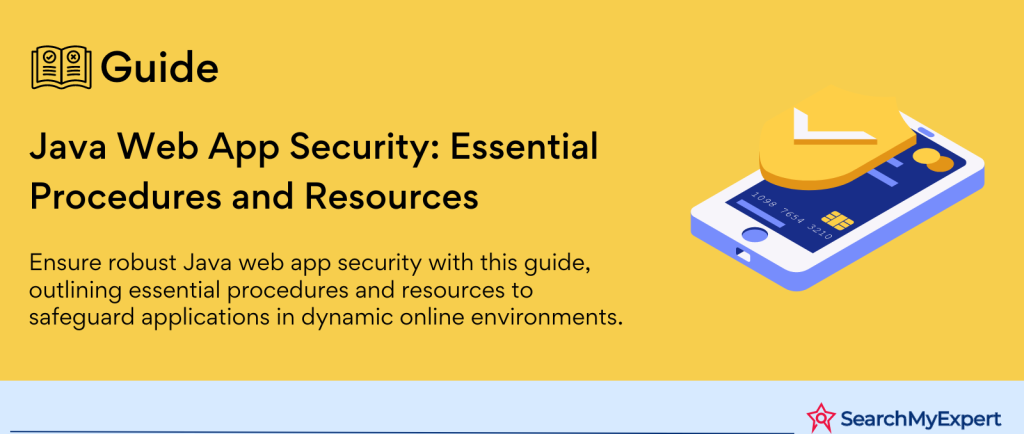The Critical Importance of Securing Java Web Applications
In today’s digital age, the security of web applications is not just a technical requirement but a critical component in safeguarding vital information and maintaining trust in the digital ecosystem. Java, renowned for its robustness and widespread usage in enterprise environments, powers numerous web applications across various industries. However, its popularity also makes it a prime target for cyber threats. This underscores the urgency and importance of implementing stringent security measures in Java web applications.
Understanding Common Threats to Java Web Applications
Java web applications, like all software, are susceptible to a range of security vulnerabilities. Some of the most prevalent threats include:
- SQL Injection:
A notorious issue where attackers manipulate SQL queries to gain unauthorized access to the database. Java web applications, which frequently interact with databases, are particularly vulnerable to this type of attack. - Cross-Site Scripting (XSS):
This occurs when attackers inject malicious scripts into web pages viewed by other users, potentially stealing sensitive information like session tokens or login credentials. - Cross-Site Request Forgery (CSRF): In this type of attack, unsuspecting users are tricked into performing actions on a web application in which they are authenticated, leading to unauthorized actions.
- Insecure Direct Object References:
This vulnerability allows attackers to access and manipulate files or data directly, bypassing authorized procedures. - Security Misconfiguration: Improperly configured security settings can expose Java web applications to various threats, making them easy targets for attackers.
The Consequences of Security Breaches in Java Web Applications
The impact of a security breach in a Java web application can be catastrophic, both for the organization and its users. The consequences include:
- Data Loss:
Sensitive information, including personal data, financial records, and intellectual property, can be stolen or irretrievably lost. - Reputation Damage:
A security breach can significantly tarnish an organization’s reputation, leading to a loss of customer trust and potentially devastating financial implications. - Legal and Compliance Issues: Breaches often lead to legal challenges and penalties, especially with stringent data protection laws like GDPR in place.
- Operational Disruption:
Security incidents can disrupt normal business operations, leading to downtime and loss of productivity.
Emphasizing Secure Coding Practices in Java Web Application Development
In the realm of Java web application development, secure coding practices are paramount in mitigating vulnerabilities and enhancing application security. The foundation of secure coding lies in writing code that is not only functional but also resilient against various cyber threats. This section explores key strategies and best practices for secure coding in Java web applications.
Simplifying Code for Enhanced Security
- Write Simple and Clean Code: Complex code can harbor hidden vulnerabilities. Simple, clean code is easier to review, understand, and maintain, reducing the likelihood of security flaws.
- Modular Coding:
Modular code, broken into smaller, reusable components, makes it easier to implement security checks and updates. - Code Reviews and Pair Programming:
Regular code reviews and pair programming sessions can identify potential security flaws that a single developer might overlook.
Robust Input Validation Techniques
- Understanding Input Validation:
Proper input validation is crucial in preventing injection attacks, such as SQL injection and Cross-Site Scripting (XSS). It involves verifying that the data supplied by users meets the expected criteria before processing. - Implementing Whitelisting:
Favor whitelisting over blacklisting. Whitelisting allows only pre-approved inputs, significantly reducing the risk of malicious data entry. - Regular Expressions for Input Validation:
Use regular expressions to define acceptable patterns for user inputs, ensuring that only valid data is processed.
Best Practices for Handling Sensitive Data
- Data Encryption: Encrypt sensitive data both in transit and at rest. Utilize robust encryption standards to ensure data confidentiality.
- Effective Use of Hashing:
For sensitive information like passwords, use strong hashing algorithms like SHA-256, coupled with salts, to enhance security. - Least Privilege Principle:
Ensure that each component of the application has only the minimum level of access necessary to perform its function, reducing the risk of data breaches.
Leveraging Secure Coding Libraries and Frameworks
- Introduction to Secure Libraries and Frameworks:
There are several libraries and frameworks designed to simplify secure development in Java. - OWASP ESAPI: The OWASP Enterprise Security API (ESAPI) is a free, open-source framework that provides a set of security controls and best practices.
- Spring Security: For applications using the Spring framework, Spring Security offers comprehensive security services, including authentication and authorization.
Fortifying Java Web Applications with Robust Authentication and Authorization
Securing Java web applications extends beyond coding practices to include robust authentication and authorization mechanisms. These layers of security are pivotal in verifying user identities and ensuring they can only access resources they are permitted to. This section focuses on strengthening these aspects to enhance the overall security posture of Java web applications.
Strengthening User Authentication Mechanisms
- The Necessity of Strong Authentication:
In an era where data breaches are common, strong user authentication is essential. It verifies the user’s identity and is a primary defense against unauthorized access. - Multi-Factor Authentication (MFA): MFA adds an extra layer of security by requiring multiple forms of verification. This could include something the user knows (password), something they have (a smartphone), or something they are (biometric verification).
- Password Hashing and Security:
Passwords, often the first line of defense, should be stored securely using hashing algorithms. Salting passwords adds another layer of protection, making them harder to crack.
Implementing Roles and Permissions for Access Control
- Understanding Least Privilege Access Control:
Implementing least privilege access control ensures that users have access only to the resources necessary for their role, reducing the risk of internal data breaches. - Roles and Permissions:
Define clear roles within the application, each with specific permissions. This simplifies managing user access and ensures consistency in access control. - Regular Audits of Access Rights:
Periodically review and update roles and permissions to align with changes in user responsibilities and organizational policies.
Secure Session Management Practices
- Securing Session IDs: Ensure that session IDs are unique, unpredictable, and protected from interception (e.g., using HTTPS).
- Session Timeouts:
Implement session timeouts to automatically log users out after a period of inactivity, reducing the risk of unauthorized access on unattended devices. - Cookie Security:
Cookies used for session management should be secure and, where appropriate, marked as HttpOnly to prevent access via client-side scripts.
Libraries and Frameworks for Secure Authentication and Authorization
- Overview of Available Tools:
Several libraries and frameworks facilitate secure authentication and authorization in Java web applications. - Spring Security:
An integral part of the Spring Framework, Spring Security provides comprehensive security services for authentication and authorization. - Apache Shiro:
Apache Shiro is a powerful and easy-to-use security framework that provides authentication, authorization, cryptography, and session management services.
Ensuring Data Security through Effective Encryption Strategies in Java Web Applications
Data security is a cornerstone of robust Java web applications, and encryption plays a pivotal role in protecting data both at rest and in transit. This section delves into various aspects of data encryption and related best practices, highlighting their critical role in safeguarding sensitive information.
The Imperative of Data Encryption
- Data Encryption at Rest:
Encrypting data at rest involves securing stored data, such as databases and file systems. This is crucial for protecting sensitive data from unauthorized access, especially in the event of a physical security breach. - Encryption in Transit:
Data in transit refers to data being moved from one location to another, such as over the internet or through a network. Utilizing protocols like HTTPS (SSL/TLS) ensures that data is encrypted while being transmitted, thereby preventing interception and eavesdropping. - Secure Storage Solutions:
Employ secure storage solutions that inherently provide encryption features. This includes databases and file storage systems with built-in encryption capabilities.
Encryption Algorithms and Libraries
- Choosing the Right Encryption Algorithm:
The choice of encryption algorithm depends on the required level of security and the nature of the data. Commonly used algorithms include AES (Advanced Encryption Standard), RSA (Rivest–Shamir–Adleman), and ECC (Elliptic Curve Cryptography). - Java Cryptography Architecture (JCA): JCA provides a framework and implementation for encryption, key generation, and key agreement, and includes a provider for accessing cryptographic services.
- Apache Commons Crypto:
A popular library that supports higher-level encryption functionalities, making it easier for developers to implement encryption in their Java applications.
Key Management Best Practices
- Importance of Secure Key Management:
The security of encrypted data is only as strong as the security of the keys used to encrypt and decrypt it. Effective key management is vital. - Key Storage and Access Controls: Store keys in secure and tamper-resistant locations, such as hardware security modules (HSMs), and restrict access to them.
- Key Rotation and Lifecycle Management:
Regularly rotate encryption keys and manage their lifecycle, including creation, usage, storage, and retirement, to prevent unauthorized access.
Data Masking and Limiting Sensitive Data Exposure
- Understanding Data Masking:
Data masking involves obscuring specific data within a database to protect it from unauthorized access. This is particularly useful in environments where data needs to be functional but not fully visible, like in testing or user support. - Implementing Data Masking Techniques:
Techniques include dynamic data masking (DDM), where data request results are masked in real-time, and static data masking (SDM), where a copy of the data is created with sensitive data obfuscated. - Other Techniques:
Beyond data masking, employ other techniques like tokenization, where sensitive data is replaced with non-sensitive placeholders (tokens).
Maximizing Security through System Hardening and Security Configuration in Java Web Applications
Securing Java web applications is not just about writing secure code or encrypting data. It also involves hardening the underlying systems and configuring them securely. This process, known as system hardening, plays a crucial role in reducing the attack surface of your application. This section discusses the importance of secure server and application configurations, as well as the tools and practices necessary for maintaining ongoing security.
Secure Server Configurations
- Implementing SSL/TLS:
Use SSL/TLS protocols to secure data transmission between the server and clients. It ensures that data is encrypted and safe from eavesdropping and tampering. - Comprehensive Logging:
Proper logging helps in monitoring and analyzing activities on the web application. Ensure that logs are comprehensive, including access logs, error logs, and transaction logs, to detect and investigate suspicious activities. - Regular Patching and Updates:
Keeping servers and software up-to-date with the latest patches is critical in protecting against known vulnerabilities.
Hardening Application Configurations
- Disabling Unused Features:
Remove or disable any unnecessary features, services, or components in the application that are not required for its functionality. This reduces the potential entry points for attackers. - Disabling Debug Options: Ensure that debug options and detailed error messages are disabled in the production environment. These can reveal critical information about the application’s architecture to potential attackers.
- Configuring Security Headers:
Implement security headers like Content Security Policy (CSP), X-Content-Type-Options, and X-Frame-Options to protect against common attacks like clickjacking and cross-site scripting.
Vulnerability Scanning and Penetration Testing
- Utilizing Vulnerability Scanners:
Employ vulnerability scanning tools to regularly scan your application for known security vulnerabilities and weaknesses. - Penetration Testing:
Conduct regular penetration tests to simulate attacks on the application. This helps in identifying and mitigating potential security issues. - Continuous Monitoring:
Use tools that enable continuous monitoring of the application for new threats and vulnerabilities.
Regular Security Audits and Maintenance
- Conducting Security Audits:
Regular security audits are essential for assessing the security posture of the application. This involves reviewing the security configurations, policies, and practices in place. - Security Maintenance Plan:
Develop a security maintenance plan that includes regular reviews, updates, and training for team members to stay informed about the latest security trends and threats. - Incident Response Plan:
Have an incident response plan in place to efficiently handle security breaches or incidents. This plan should include steps for containment, eradication, and recovery.
Implementing Continuous Monitoring and Robust Incident Response in Java Web Applications
In the dynamic landscape of web application security, the need for continuous monitoring and an effective incident response strategy cannot be overstated. Java web applications require vigilant monitoring to detect security events promptly and robust incident response planning to mitigate breaches effectively. This section delves into these critical aspects, emphasizing their role in maintaining the security and resilience of Java web applications.
Logging and Monitoring Practices for Security Events
- Importance of Logging: Logging is a fundamental practice for security monitoring. It involves recording events that occur within the application, such as user actions, system errors, and transactions.
- Effective Monitoring Strategies:
Implement continuous monitoring strategies using tools that analyze logs in real time. This helps in the early detection of unusual activities or potential security threats. - Utilizing Security Information and Event Management (SIEM):
SIEM systems aggregate and analyze log data from various sources, providing a comprehensive view of the security state of the application.
Incident Response Planning and Procedures
- Developing an Incident Response Plan:
Prepare a detailed incident response plan that outlines procedures for addressing security breaches. This plan should include roles and responsibilities, communication protocols, and steps for containment, eradication, and recovery. - Timely Mitigation of Breaches:
Rapid response is crucial in mitigating the impact of security incidents. The incident response plan should enable quick decision-making and action to limit damage. - Regular Testing and Updating of the Response Plan:
Conduct regular drills and update the incident response plan based on new threats, vulnerabilities, and lessons learned from past incidents.
Incident Recovery Strategies
- Minimizing Damage:
Implement strategies to quickly contain and control the situation to minimize damage. This might involve isolating affected systems, blocking malicious traffic, or applying emergency patches. - Restoration of Operations:
Develop procedures for safely restoring systems and services to normal operation. This includes data recovery from backups and ensuring that vulnerabilities are addressed. - Post-Incident Analysis:
Conduct a thorough analysis of the incident to identify the root cause and take corrective actions to prevent similar incidents in the future.
Continuous Improvement through Learning from Incidents
- Learning from Security Incidents: Each security incident provides valuable insights. Analyzing these incidents helps in identifying gaps in security measures and improving response strategies.
- Updating Security Measures: Use the knowledge gained from incidents to update security policies, practices, and technologies.
- Fostering a Culture of Continuous Improvement: Encourage a culture where continuous learning and improvement in security practices are integral parts of the organizational ethos.
Leveraging Essential Resources and Tools for Enhanced Security in Java Web Applications
Ensuring the security of Java web applications is a continuous process that requires access to the right resources and tools. This section offers a comprehensive list of essential security resources and tools, discussing their relevance and application in the realm of Java web application security. It also emphasizes the importance of staying updated with the latest security threats and best practices.
Key Security Resources
- OWASP (Open Web Application Security Project):
A vital resource for web application security. It provides extensive documentation, guidelines, and best practices on web application security, including the famous OWASP Top Ten, a list of the top ten most critical web application security risks. - NIST (National Institute of Standards and Technology): Offers cybersecurity frameworks and guidelines widely respected in the industry. NIST’s publications provide comprehensive insights into security standards and best practices.
- Security Libraries and Frameworks:
Utilize robust security libraries like Apache Shiro, OWASP ESAPI, and Spring Security. These provide ready-to-use functions and classes that simplify implementing security measures in Java applications.
Tools for Secure Coding and Vulnerability Management
- Static Application Security Testing (SAST) Tools:
Tools like Checkmarx, SonarQube, and Fortify offer static code analysis to detect vulnerabilities in the application source code. - Dynamic Application Security Testing (DAST) Tools:
These tools, including OWASP ZAP and Burp Suite, test the application in its running state to identify security issues. - Dependency Scanners:
Tools like OWASP Dependency-Check analyze project dependencies for known vulnerabilities, an essential step given the widespread use of libraries in Java projects.
Monitoring and Incident Response Tools
- Security Information and Event Management (SIEM):
Solutions like Splunk and IBM QRadar aggregate and analyze data from various sources to detect and respond to security incidents. - Intrusion Detection Systems (IDS): Tools like Snort or Suricata help in monitoring network traffic and identifying suspicious activities.
- Incident Response Platforms:
Tools like TheHive, PagerDuty, and OpsGenie assist in managing and responding to security incidents efficiently.
Staying Updated with Security Trends and Best Practices
- Security News and Forums:
Follow platforms like SecurityWeek, Krebs on Security, and cybersecurity forums to stay informed about the latest threats and trends. - Webinars and Online Courses:
Engage in continuous learning through webinars, online courses, and certifications from reputed organizations. - Joining Developer Communities: Participate in communities such as Stack Overflow, GitHub, and local or online developer meetups to share knowledge and learn from peers.
Conclusion:
In summary, securing Java web applications is an intricate process that demands attention to various aspects, ranging from secure coding practices and robust authentication mechanisms to effective data encryption, system hardening, and continuous monitoring. This comprehensive guide has traversed through each of these critical areas, providing insights into best practices, tools, and resources available to safeguard Java web applications against evolving cybersecurity threats.
Let our Java Development Service Company be your technology partner.
Table of Contents
Toggle






